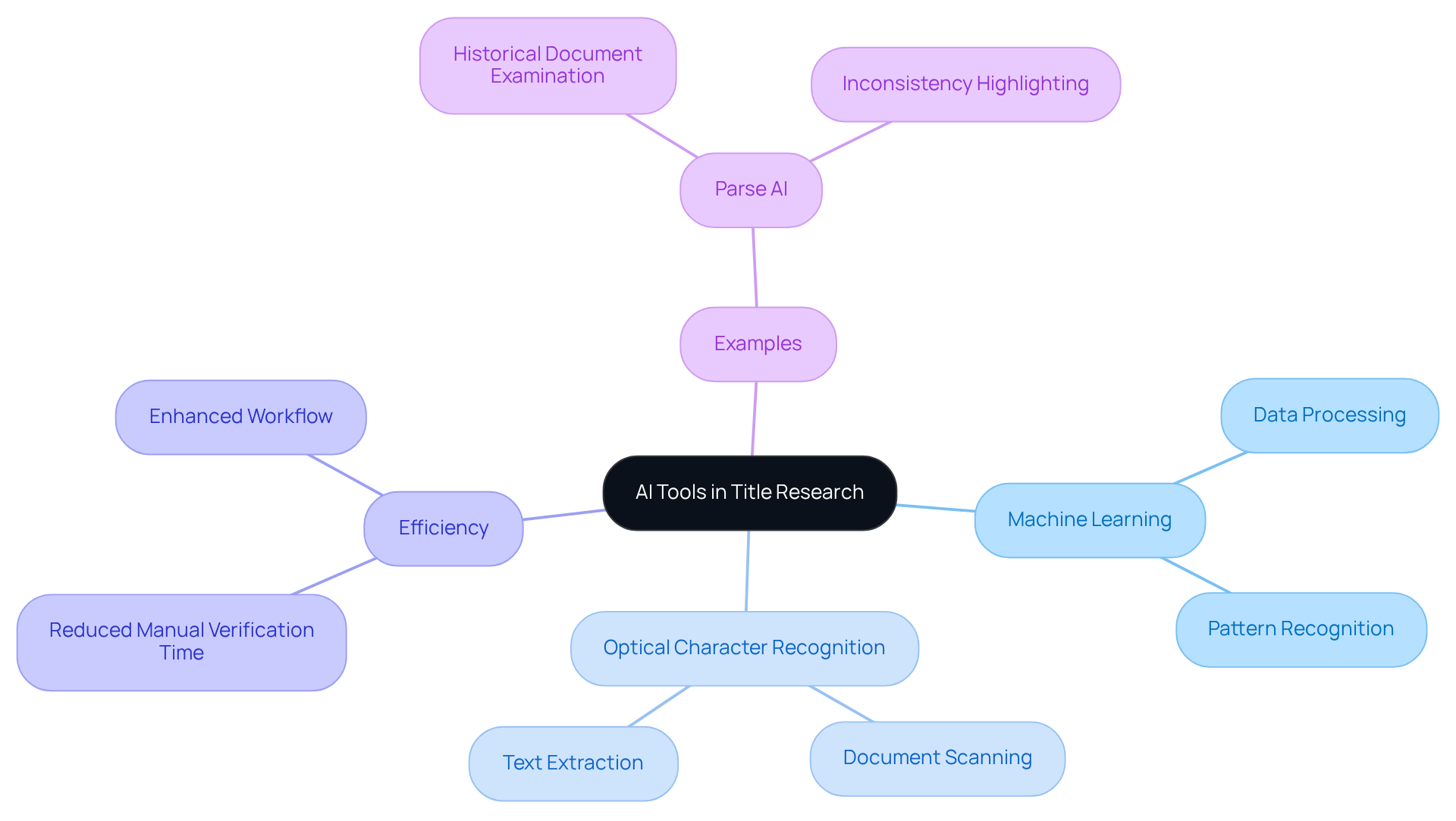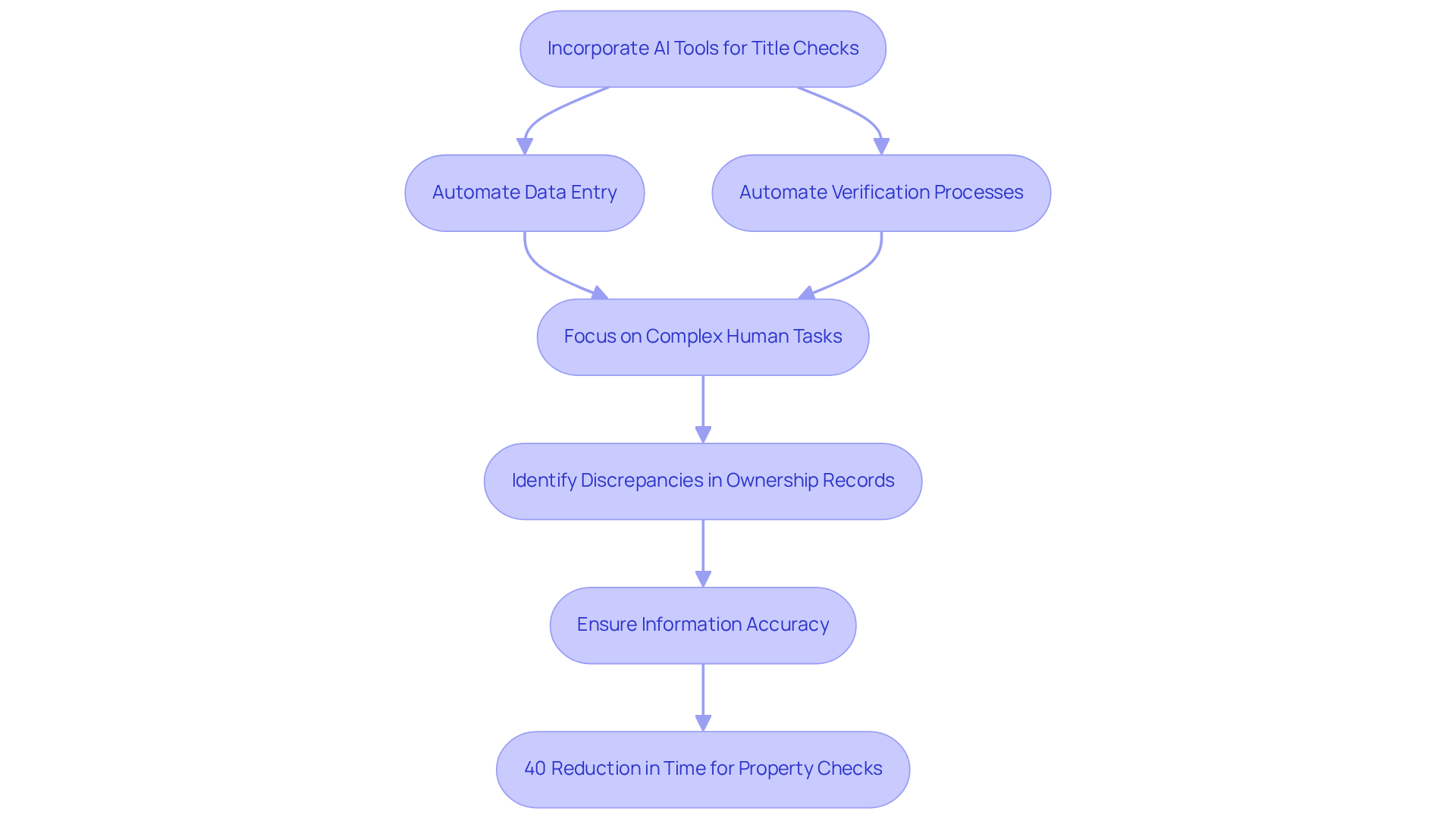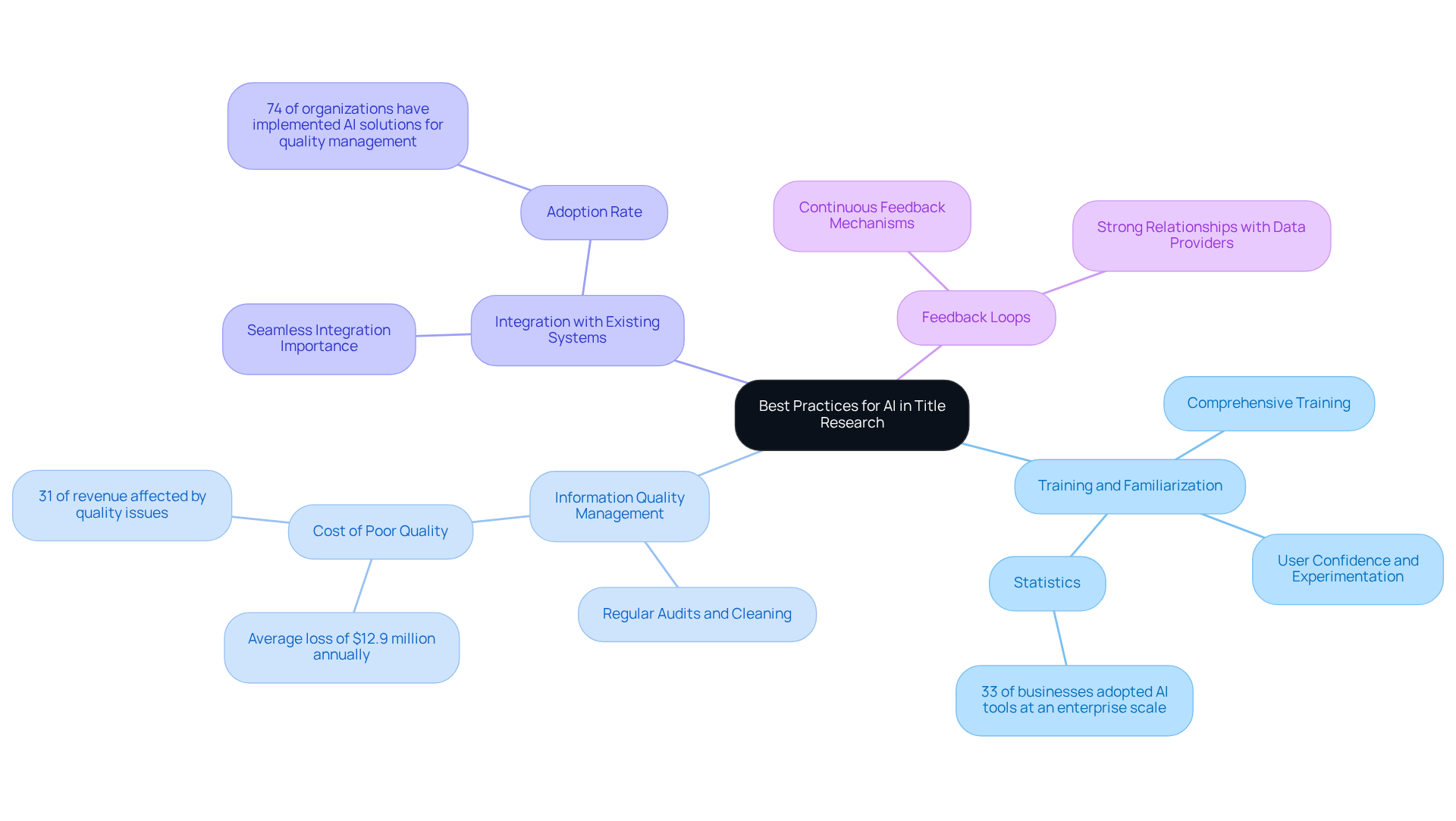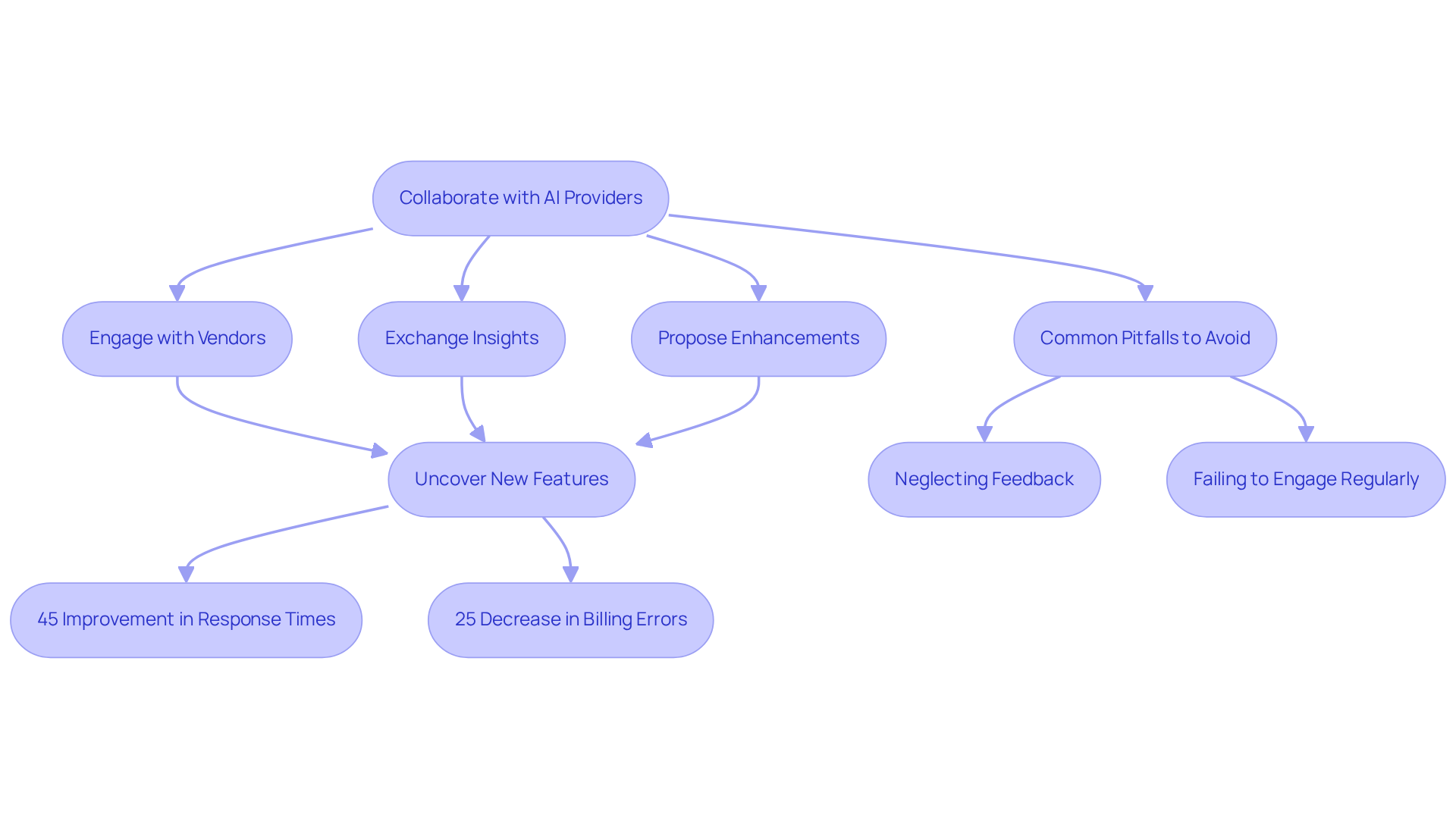Overview
AI tools for title and ownership checks significantly enhance accuracy by automating the extraction and analysis of information from document records. This automation reduces the time required for manual verifications, addressing a critical challenge in the industry. The article illustrates this through examples of AI applications, such as Parse AI, which improve workflow efficiency and accuracy in property ownership verification. By swiftly identifying discrepancies and inconsistencies in records, these tools not only streamline processes but also reinforce the reliability of property documentation.
Introduction
AI technologies are revolutionizing title research, delivering unmatched speed and accuracy in verifying property ownership and related documents. By harnessing machine learning and optical character recognition, these innovative tools streamline the verification process and enhance the efficiency of real estate transactions.
However, as organizations increasingly depend on AI for title and ownership checks, questions about best practices for implementation and potential challenges emerge. What strategies can professionals adopt to fully leverage these AI advancements while mitigating risks?
Understand AI Tools and Their Applications in Title Research
AI applications, particularly those utilizing machine learning and optical character recognition, are revolutionizing research by automating the extraction and analysis of information from document records. These powerful AI tools for title and ownership checks can swiftly process extensive volumes of data, identifying critical details such as property ownership, liens, and encumbrances.
For instance, platforms like Parse AI can meticulously examine historical document records, highlighting inconsistencies and significantly reducing the time required for manual verifications. Understanding these applications empowers researchers to select the most tailored to their specific needs, thereby enhancing their overall workflow efficiency.

Leverage AI for Enhanced Efficiency and Accuracy in Title Checks
The incorporation of AI resources in document verification significantly enhances both effectiveness and precision. By automating data entry and verification processes, AI allows researchers to concentrate on intricate tasks that necessitate human insight.
For instance, AI tools for title and ownership checks can swiftly identify discrepancies in ownership records, ensuring the accuracy of information before transactions proceed. A notable case study highlighted a real estate company that utilized AI tools for title and ownership checks, resulting in an impressive 40% reduction in the time required to complete property checks.
This exemplifies the considerable advantages that AI tools for title and ownership checks can provide to the documentation examination process, ultimately streamlining workflows and enhancing overall precision. Furthermore, Parse AI collaborates with land service experts to continually improve its offerings, addressing the evolving challenges in property analysis.
While numerous studies report favorable outcomes from AI implementation, it is crucial to remain cognizant of to ensure their effective application in real estate.

Implement Best Practices for Effective Use of AI in Title Research
To effectively implement AI tools for title and ownership checks in title research, professionals must adhere to several best practices:
- Training and Familiarization: Comprehensive training is essential for all team members to utilize AI tools for title and ownership checks effectively. Organizations that invest in user training can quickly adapt to AI innovations, fostering confidence and encouraging experimentation.
- Information Quality Management: Regular audits and cleaning of information are crucial to ensure that AI systems operate accurately. Poor information quality can cost organizations significantly; studies indicate that it can lead to losses averaging $12.9 million annually, with businesses reporting that 31% of their revenue is affected by quality issues.
- Integration with Existing Systems: Selecting AI tools for title and ownership checks that seamlessly integrate with current title research systems is vital to avoid disruptions in workflow. Notably, 74% of surveyed organizations have already adopted some AI solution for quality management, underscoring the trend and urgency for integration.
- Feedback Loops: Establishing mechanisms for continuous feedback on AI performance allows teams to identify areas for improvement and adapt their strategies accordingly. Additionally, fostering strong relationships with data providers is crucial for maintaining data quality.
By following these practices, property researchers can significantly enhance the reliability and efficiency of their processes, ultimately leading to better outcomes in ownership verification.

Collaborate with AI Providers for Continuous Improvement and Adaptation
Collaboration with AI providers is crucial for the continuous improvement of title research processes through the use of AI tools for title and ownership checks. Title researchers must actively engage with their to exchange insights on performance and propose enhancements. Frequent discussions can uncover new features that align with industry demands, ensuring that these resources adapt effectively.
For example, a title research firm that closely collaborated with its AI provider successfully integrated AI tools for title and ownership checks that automatically flag potential legal issues in title documents. This innovation significantly enhanced their compliance and risk management capabilities. Furthermore, leveraging AI resources has been shown to yield a 45% improvement in customer query response times and a 25% decrease in billing errors, highlighting the tangible benefits of such collaboration.
However, it is vital to avoid common pitfalls, such as neglecting to provide specific feedback or failing to engage regularly with vendors, as these can undermine the effectiveness of these resources. By cultivating a proactive partnership, title researchers can refine their AI tools for title and ownership checks and achieve innovative solutions tailored to the unique challenges they encounter in the field.

Conclusion
The integration of AI tools in title and ownership checks represents a pivotal advancement in enhancing the accuracy and efficiency of title research. By harnessing the power of machine learning and optical character recognition, these technologies streamline the process of verifying property ownership. This enables researchers to concentrate on more complex tasks that require human insight. The advantages of utilizing AI extend beyond mere automation; they encompass substantial reductions in time spent on verifications and improved accuracy in identifying discrepancies.
Throughout the article, key insights have been shared, underscoring the importance of selecting suitable AI resources, implementing best practices, and maintaining effective collaboration with AI providers. From training team members to ensuring high-quality information management, each recommendation serves to bolster the reliability of title research processes. Case studies illustrate the tangible improvements that organizations have experienced, such as significant time savings and enhanced compliance capabilities. These examples underscore the transformative potential of AI in this field.
Ultimately, embracing AI tools for title and ownership checks transcends the need to keep pace with technological advancements; it is about redefining the standards of accuracy and efficiency in title research. As the real estate landscape continues to evolve, it is crucial for professionals to remain proactive in adapting these technologies, fostering partnerships with AI vendors, and continuously seeking improvements. By doing so, organizations can not only enhance their operational effectiveness but also elevate the overall quality of service provided to clients, ensuring a more reliable and streamlined approach to property verification.
Frequently Asked Questions
What are AI tools used for in title research?
AI tools are used to automate the extraction and analysis of information from document records in title research, enhancing efficiency in identifying property ownership, liens, and encumbrances.
How do machine learning and optical character recognition contribute to title research?
Machine learning and optical character recognition enable AI applications to swiftly process large volumes of data, facilitating the identification of critical details in document records.
Can you provide an example of an AI tool used in title research?
An example of an AI tool used in title research is Parse AI, which examines historical document records to highlight inconsistencies and reduce the time needed for manual verifications.
What benefits do AI tools offer to researchers in title research?
AI tools empower researchers by allowing them to select suitable resources tailored to their specific needs, thereby enhancing overall workflow efficiency.




